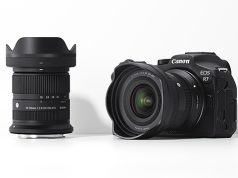The great thing about camera phones is a good percentage of the population carries them; the not-so-great thing about camera phones is image quality hasn’t improved much over the years and retailers aren’t gaining much in terms of print sales from these devices. Yet, it was only a few years ago that they held such promise.
“We see a little bit of a slow down on camera phone technology improvements,” states John Prendergast, Vice President, Product and System Development, Fujifilm. “For a while it was leapfrogging—some people were going to 2-megapixel phones and there was talk about 3- and 4-megapixel phones. Yet, we haven’t seen those come to market so quickly. From a technology point, the focus for today’s U.S. phone carriers seems to be about streaming video, Webcasting, and TV. You don’t see as much about picture taking and sharing as you did two years ago. I don’t want to say we’ve moved on, but the focus has changed and I don’t see (carriers/manufacturers) investing in really high-end camera phones.”
“Camera phones used to be a big feature,” reiterates Lisa Walker, President, International Imaging Industry Association (I3A), “now it’s sort of a given. It’s not so much a question of whether or not the phone has a camera, but what are the specs of the equipment.” Walker believes, from the camera phone standpoint, there has been an increase in the overall quality of camera phones. “However,” she explains, “the specs don’t really translate directly from a digital still camera to a camera phone for reasons most people are aware of—but may not have thought about—light, lenses, and image processing capabilities.
“Because of the size constraint on phones, 2-megapixels in a camera phone is not the same quality as the same 2-megapixels on a digital camera. And there are other factors such as lens quality restraints and robustness. Everything on a phone has to be more robust because they’re taken everywhere and treated more roughly. People drop their cell phones rather routinely and expect them to keep working. If they drop their digital camera, they’re horrified and assume they broke something. And because the form factor is so small, the flash is typically next to the lens. Manufacturing is another issue,” she continues. “In general, cell/camera phones are manufactured in hundreds of millions of units, and digital cameras in maybe tens of thousands. Quality control is more difficult because of the volume of manufacturing.”
In addition, Americans have been trained to keep their wallets closed. “In Japan and Europe, consumers are willing to pay $500 and up for a phone with a decent camera in it,” says Walker. “So they tend to get the product with better quality lenses, image processing, flash capabilities, etc., all the way down to the chip set in the whole camera module. But U.S. consumers won’t pay for it. Primarily,” she states, “this market is controlled by the carriers who’ve trained U.S. consumers that they don’t have to pay for the product (as long as they sign the contract).”
Because quality camera components add cost, the camera module gets stripped down for distribution in the U.S. This situation doesn’t exist in Europe and Japan where consumers are accustomed to/and willing to pay more for a phone. Walker believes that will eventually change.
Where’s the Profit for Specialty Retailers?
More than 500 million camera phones were shipped in 2006, and that number is expected to almost double by 2010. In 2007, more images were shot with camera phones than with digital cameras. According to I3A data, some of the reasons people don’t print images from their cell phones include, poor image quality, a preference for viewing images on handsets or PCs, and difficulty of getting prints from camera phones that don’t have removable media.
Most photo retailers don’t carry camera phones as the contracts make them too complicated to sell. Still, they were supposed to be a goldmine when it came to print services. Max Dittleman of East Greenwich Photo in Rhode Island says the number one problem his store faces when printing images from camera phones is getting them from camera to kiosk. “Infrared was the first way,” notes Dittleman, “and then Bluetooth. Now, the best way is removable media.
“I’m 28 years old and tech savvy,” states Dittleman, who’s proud of the fact that he’s been able to set the time on a microwave since he was a young boy. “I’ve always had a knack for that sort of thing. With electronics, if I fiddle around long enough, I’ll get it. But I could not figure out how to do this even with my own camera phone (which has non-removable media). I had to refer to my owners’ manual, which didn’t help because it didn’t make sense. So, no way is Sally soccer mom going to figure it out,” he says. For camera phones that have removable media cards (macro SD cards), Dittleman uses a macro SD adapter so he can pop the cards into his kiosk—an Agfa D-Lab. “Then it’s easy,” he states.
“The really exciting thing about cell phone technology is that most people have a phone on them 95% of the time,” continues Dittleman. “The potential for (retailers) to print photos from someone who has their ‘camera’ on them all the time is that much greater. It’s a numbers game. They shoot 100 pictures and maybe they’ll print ten—and that’s ten photos they wouldn’t have taken had they not had their ‘camera’ with them.”
Simpler Printing Solutions
Now, thanks to the efforts of some manufacturers, those ten images are a lot easier to print. According to Fujifilm’s Prendergast, the company has been watching this market for a long time because it thought it would be the new wave of getting additional images—not replacement images—into the industry. Hence, Fujifilm, along with several other imaging companies, embarked on a mission to figure out how to get these prints to its retail partners and create those incremental revenues. Removing the technology hurdles and working with carriers was the first step. Half the challenge is all the carriers’ phones utilize different technologies.
“Our first launch, in 2003, was an application called ‘Get the Picture Mobile’ that could be downloaded to AT&T handsets,” says Prendergast, “‘Get the Picture’ is the theme we’ve used to drive the retail printing. We have a standard Web site service where people can upload their digital camera pictures and print to retail locations. We’ve extended that concept to the mobile world. Our first large-scale retail printing service was in 2004 with Sprint—the leading carrier when it came to photo ‘capture-and-print’ from camera phones. They lead the way with their Picture Mail Service, which was a combination of handset and Web site where people could upload their photos, interact with those photos, etc.”
Via Sprint’s Picture Mail Web site, consumers could connect to Fujifilm’s “Get the Picture Service.” “Sprint made it a nice easy process that allowed consumers to take a picture, press a button and send it right to the Web site,” says Prendergast. “To our surprise, we found consumer acceptance to be very high. Plus, they understood it wasn’t going to be the
same quality of a film picture on a 3-megapixel digital camera. And retailers were all making additional revenue from a source of images they previously couldn’t tap into.
“We took that model and continued down the path, and in 2005 partnered with Nextel (Nextel Photo Share). It’s the same premise—consumers take their Nextel phone, take a picture, upload it to the Web site and order prints. Consumers can do the same thing with their phones, but we found that about 95% to 99% of printing was coming from the Web site. People collected photos over time and sent them at their leisure. Although capture was spontaneous, printing was more deliberate. Order sizes,” notes Prendergast, “were fairly small—about fifteen images as opposed to the typical thirty (from a camera).”
Most recently, Fujifilm joined forces with Verizon Wireless, whose customers can manage and print their photos online at Pix Place (www.vzwpix.com). After uploading their photos with their camera phone or PC, customers simply select Order Prints from Pix Place and search by zip code for the nearest participating retail location (or have them delivered to their homes).
Rather than choose one printing solution, Fuji chose many. “Fujifilm does not want to bet on consumer behavior, so we have a printing solution in retail stores (for removable media), and online (sites linked for retail printing) and from handsets. It’s all the same infrastructure for us,” concludes Prendergast. “We change the front end a little bit and cover all our bases.”
Fujifilm’s network of “Get the Picture Online Service” partners includes Cingular (AT&T), ALLTEL, Sprint (Nextel) Photoshare Service, Sprint Picture Mail Service, MSN communities, Verizon’s Pix Place, Microsoft XP Online Print Wizard, Microsoft Digital Image Library, Microsoft Photo Mail and Microsoft Photo Story.
Many manufacturers are also looking at this market from a new product standpoint as well. For consumers that like to print from home, Kodak’s new EasyShare 5300 All-in-One Inkjet Printer features Bluetooth wireless technology (with the Kodak Wireless 2.0 USB Bluetooth Adapter), so users can easily print camera phone pictures even from across a room.
The adapter, which is compatible with Kodak EasyShare All-in-One printers lets consumers go wireless and expand printing options. The adapter retails for $49.99 and accepts JPEG/EXIF image file types from Bluetooth Wireless Technology-enabled devices such as camera phones, PDAs, PCs, and digital still cameras.
Canon, among others, had come to market last year with a wireless printer, the PIXMA iP4000R that delivered prints from images sent via their wireless camera, the SD430. Nikon and Kodak also delivered wireless digicams around the same time period. Add to this several digital frame manufacturers who have come out with models that wirelessly accept images from digicams and camera phones equipped to send them. From what we saw at the recently concluded 2007 CTIA Show more product such as this is on the way. As U.S. consumers get more accustomed to wireless technology you can expect product intros of this type to increase dramatically.
How the User Feels
When you look at the camera phone market from the perspective of the end user, the opinions and usage habits seem to run very closely along generational lines. While 44 year old Chris Lundie recently purchased a new Nokia cell phone, the addition of a camera in the phone wasn’t high on his list of must-have features. “It (a camera phone) wasn’t in my plans initially. When I bought the phone the camera was simply a part of it,” he began. “I’ve used it from time to time, and I’ll admit it’s a fun feature, but I would never rely on it as my sole memory capture device.”
17 year old Kealy Lee had a dramatically different take on her 2-megapixel Samsung cam phone saying, “I’ve always considered my cell phone as a vital part of my life and the addition of the camera feature simply took that to another level. I use the camera feature constantly to capture everyday events that I would never take a camera to and find that I’m even starting to use it a lot now even at bigger events in my life, birthdays, holidays and such.”
Lee added that she expects the technology to make it easier for her to get prints and when that occurs, “I will make more prints,” she told us, but she added, “Right now the prints aren’t a big part of the mix for me. I’m happy sharing the images by passing the phone around and/or e-mailing them.”
As this market continues to evolve one thing is certain, with almost 1 billion camera phones expected to be in circulation by 2010, you can expect the number of camera phone images to reach the trillions shortly thereafter. Making sure you’re prepared with a service to print these images is undoubtedly a smart move for imaging retailers. yy





